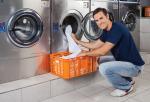LOS ANGELES — Beverly Blank says her California laundromat developed a nice reputation for its fluff and fold services, striving to set itself apart from the 60 or so competitors that could be found within a mile and a half.
When the facility burned down in 2012, Blank shifted gears to work as a fluff and fold consultant and trainer. Today, her goal is to provide strategic consulting services, including staff training and procedures, to her clients.
She admits being shocked by the number of people who express interest in launching a fluff and fold service yet “have no idea of what’s going on with the competition.”
For each new client who approaches her with thoughts of offering fluff-and-fold laundry services, evaluating the competition is a key part of her guidance for them.
“What’s important is, and in all the businesses I’ve had—and I’ve had several—I need to know what the competition is doing,” Blank says. “I always liked to be the best. We’re in this business to make money and be successful, so if I can find out what someone else is doing … then I can say this is something we’re going to offer that they’re not. That may cause (the area resident looking for a laundry) to come to our store, because he’s getting the service that he wants.”
(While her consultancy’s focus is on fluff and fold, Blank says the same type of approach can work for self-service laundromat investors or owners assessing the competing stores near them.)
“One of the things I insist my clients do is to conduct a ‘secret shopping’ visit to all fluff-and-fold competitors within three miles before launching the services,” she says.
Blank arms them or their representative with a lengthy checklist of questions to answer upon visiting.
“Rather than standing around, looking very obvious, I tell them to do a load of laundry,” she says. “While it’s being washed and dried, you can get a lot of information and be rather subtle in your approach.”
And if the client is uncomfortable with the thought or fears their competitor may recognize them, Blank says she’s willing—for a price—to put on her “Dolly Parton wig and glasses” and take 20 pounds of dirty clothes to the laundry in question, all for the sake of gathering information.
“The bottom line is we want to find out what unique selling positions or ideas they have,” she says.
CHECKING OFF WHAT’S IMPORTANT
The nature of your laundry operation is going to influence the information that you seek. If your store is unattended and offers self-service only, then you may limit your focus to just that. If you operate a full-service laundry that offers wash/dry/fold services with pickup and delivery, then the scope of your inquiry will be broader.
Customer needs can vary greatly, so keep that in mind while doing reconnaissance.
“The fluff and fold customer is very different than the walk-in customer,” Blank says. “The fluff and fold customer doesn’t care if you have big machines, small machines. If you have vending. Unimportant. The fluff and fold customer is going to spend five minutes with you, dropping off laundry, picking it up. He’s not interested in the laundromat per se.”
Blank’s evaluation checklist covers 30-plus items and references some of the same features and qualities that an investor or owner looking to buy an existing store might be curious about.
Here’s a sampling:
- What is the laundry’s visibility from the street?
- What is the state of its exterior signage? Its exterior appearance overall?
- How is the accessibility? Are security cameras visible?
- What are the store hours?
- How large is the laundry? How clean inside?
- Is interior signage adequate?
- How is the store staffed: none/partially/fully?
- Describe the quality of staff: helpful, pleasant, etc.?
- Payment acceptance: coins, card, etc.?
- Washers: How many? What capacities? What condition? Pricing?
- Dryers: How many? What capacities? What condition? Pricing?
- Does the location offer any ancillary services?
- Are there vending machines? Is there TV available? Wi-Fi?
- Does the store offer fluff and fold services? Pickup and delivery?
- Is fluff and fold priced by the pound or by the bag? Is there a minimum poundage?
- If same-day service is available, is there an additional charge?
Wondering how your laundry compares to the businesses you’re competing against can create a certain level of stress. When evaluating a competitor, besides the intelligence you gather, the act itself may boost your confidence because there are fewer uncertainties. Rather than fear what you don’t know, you have a firm grasp of your competitors and how best to position your operation relative to theirs.
“If one of your primary goals is to make this successful and make money, you need to do that,” Blank says. “You need to change pricing, procedures. Sometimes you have to replace staffing because they’re not living up to your expectation.”
Once you’ve started, continue evaluating your competition infrequently, Blank suggests: “I don’t think a monthly visit to your competition is necessary. I would say every six months or so. I don’t think changes happen (more often). A new store, you would want to go to, or a change of ownership. But I think every six months is more than ample to check out what other people are doing.”
On Thursday: Store owners describe their exploratory efforts


Have a question or comment? E-mail our editor Bruce Beggs at [email protected].











